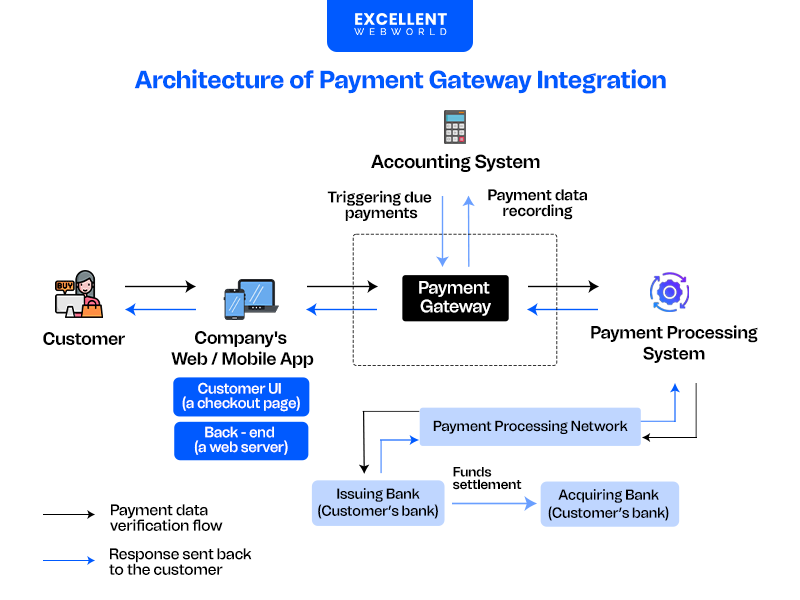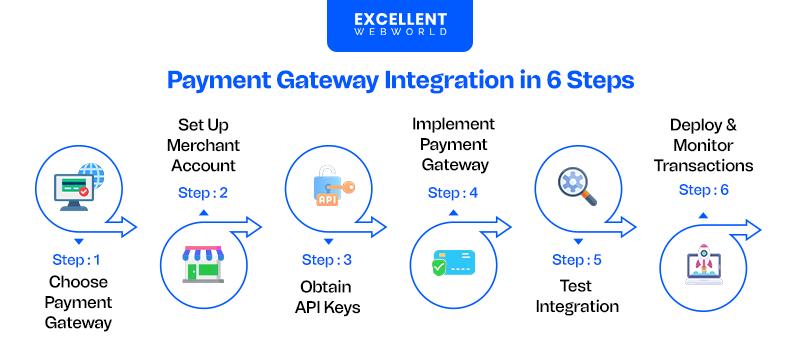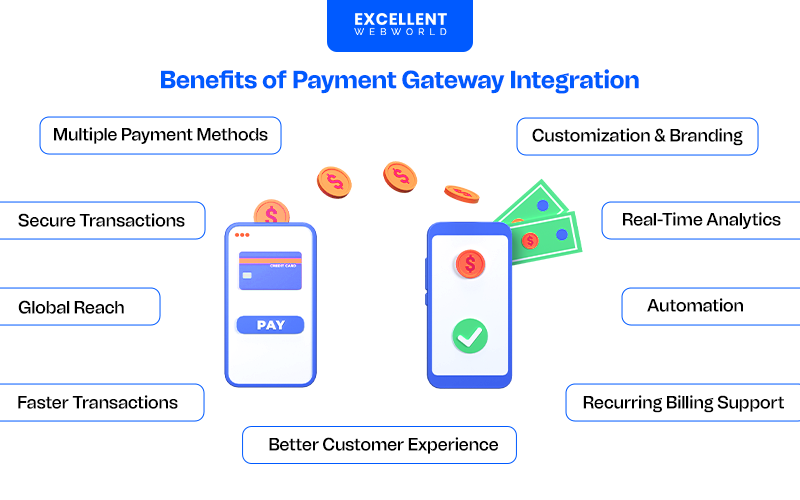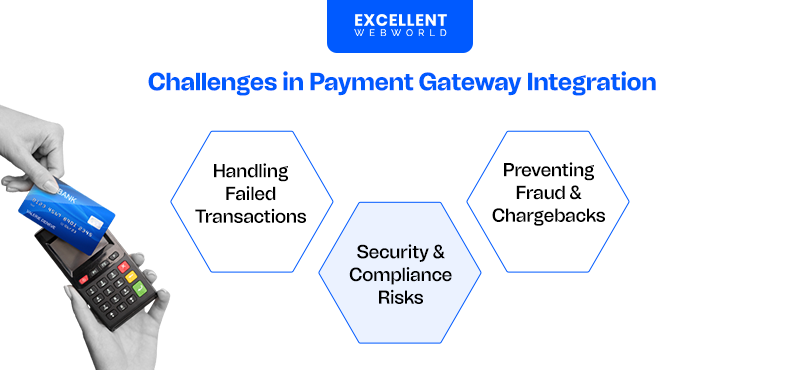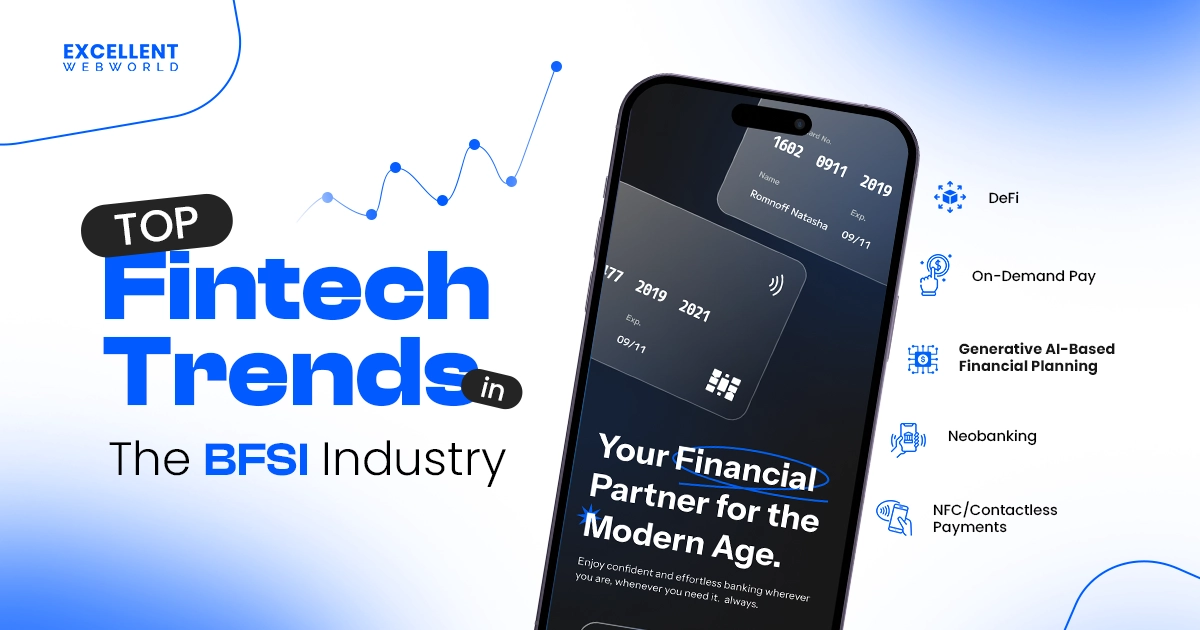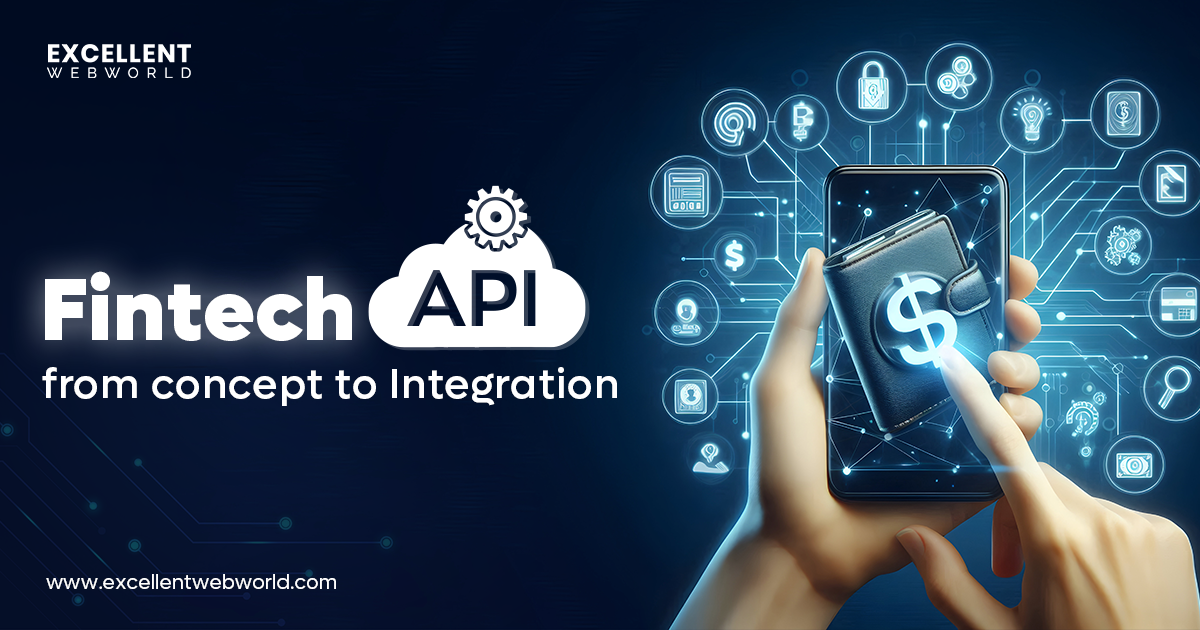A little inconvenience to users is directly proportional to a big loss: A user loved the products you have on your eCommerce platform, added them to their cart, and moved forward with checkout. But the payment step hits the frustration for them as it doesn’t support their preferred payment method. Within seconds, they drop the plan, and you have lost a sale. That’s why doing the right payment gateway integration with the right steps and the right type is crucial.
E-commerce sales at a global level are forecasted to reach almost USD 7.4 trillion in 2025, which is 74% greater than the sales of 2020 (Source: EMARKETER). You should understand how to manage payment transactions that will tap your online business idea into this growing market. Payment gateway integration into a website or mobile app is the key step in enabling a fully functional online store.
The purpose of payment gateway integration is not limited to accepting online payments only. It’s about enhancing customer experience, increasing conversion rates, and boosting transaction security. A smooth and secure checkout process through a payment gateway can build customer trust & loyalty towards your brand. In this blog, we will discuss what a payment gateway is, how it works, and how to integrate one, including type, tech stack, use cases, and challenges.
How Does a Payment Gateway Work? (Architecture of Payment Gateway)
Before stepping up into the payment gateway integration process, it’s important to understand how a payment gateway actually works. Payment gateway solutions exist in both online and physical forms. A physical payment gateway is the POS system you see at retail stores. On the other hand, a digital payment gateway is used for ensuring smooth online transactions for eCommerce businesses and mobile apps.
Check this step-by-step breakdown of how a payment gateway processes transactions:
What Are the Popular Types of Online Payment Gateways?
While doing payment gateway integrations, it is very important to understand which type is more beneficial to your business. Every payment gateway type has its own different functionality and capabilities. As per your business needs and goals, you have to decide which type is best for you. Let’s look at some key types of payment gateways here:
| Payment Gateway Type | Description | Payment Gateway Examples |
|---|---|---|
| Hosted Payment Gateways | This payment gateway solution redirects customers directly to the third-party page to proceed with the payments. The payment gateway integration cost for hosted gateways is generally lower than other types. This is because most of the technical aspects are handled by the provider. | |
| Self-Hosted Payment Gateways | In this type, merchants collect the complete customer payment details on their site and send them to the payment gateway for processing. Like this merchant has more control over payment processing. | |
| API-Based or Non-Hosted Payment Gateways | Non-hosted payment gateways offer complete command over the payment procedures to retailers. These are the online payment APIs integrated into websites and apps that allow an easy checkout process without redirection. | |
| Local Bank Payment Gateways | As the name suggests, this payment gateway is provided by banks, which allows direct integration with merchant accounts. This can help gain the trust of the local customers. | |
| White-Label Payment Gateways | This means the payment gateway integration is of another brand; still, you can rebrand it with your business name. |
How to Integrate Payment Gateway: 6 Easy Steps of Payment System Integration
Payment gateway integration into a website and mobile app involves many crucial steps, which we will see in this section. The particular online payment gateway integration process can vary based on the payment gateway you choose and the platform on which your website or app is built. Here, let’s learn some general step-by-step processes:
Step 1: Choose Your Payment Gateway
When developing a payment app or eCommerce website, the first step in the payment gateway integration process is to select an appropriate payment gateway that aligns with your business goals. Stripe, PayPal, Authorize.Net, and Square are popular payment gateway examples in the USA. Similarly, PayTabs, Tap, BayanPay, and 2Checkout are examples of top payment gateways in Saudi Arabia.
Consider factors such as transaction fees, payment acceptance type, security measures, and compatibility with your eCommerce platform or fintech app when choosing a payment gateway provider.
Step 2: Set Up Your Merchant Account
As per the payment gateway type, you may have to set up your merchant account. Some payment gateway providers like Stripe combine merchant account functionality with payment gateway setup.
To register a merchant account, your business should comply with all the legal formalities. Things like tax IDs, business bank accounts, KYC, etc., should be up to the mark while registering for your merchant account.
Step 3: Obtain API Keys
After successfully setting up your merchant account, you will need an API key to integrate the payment gateway. API keys are the unique identifiers that are used to connect an online business’s app or website to the payment gateway services.
They are part of the complete payment gateway system, which enables secure communication between the payment gateway and the business platform. With the help of these keys, your website or payment app can directly interact with the payment gateway server.
Step 4: Implement Secure Payment Gateway Integration into Website or App
Start integrating a payment gateway SDK or REST API into your website or mobile application. For Android, you can add dependencies in Gradle, and for iOS, opt for CocoaPods or Swift Package Manager.
With the SDK approach, you can get pre-built UI components and payment-handling methods. On the other hand, with an API-based approach, you will experience secure HTTPS communication and implement proper request authentication.
A well-optimized checkout process is key to providing the best customer experience and reducing the cart abandonment rate. Key features such as one-click payments, embedded payment forms, and multiple payment options improve conversion rates. Real-time transaction tracking with webhooks ensures seamless payment processing and automated notifications.
Hiring a leading payment gateway integration service provider like Excellent Webworld can help you streamline the integration process, ensure compliance, enhance security, and deliver a smooth user experience to businesses and customers.
Step 5: Test the Payment Gateway Integration
Before proceeding with making the payment gateway live, it is crucial to test it thoroughly. Most of the payment gateways offer a ‘sandbox’ or testing environment where you can perform the pre-test of payment gateway integration. You can make test purchases to make sure that everything is working correctly in the payment procedure.
Step 6: Deploy and Monitor Transactions
After successful testing of payment gateway integration, switch to live API keys and deploy it. At this point, your payment gateway should be accessible to your customers. They should be able to make purchases and process payment with your eCommerce payment gateway integration.
Ensure the security of your customer’s sensitive data throughout this process. Always opt for a secure and encrypted connection for payment gateway integration. Also, make sure it complies with the requirements of the Payment Card Industry Data Security Standard (PCI DSS) in case you are managing credit card information.
Tech Stack for Online Payment Gateway Integration
For successful payment gateway implementation, considering the following technology stack can be beneficial for your business. It ensures seamless and effective payment gateway integration.
| Component | Technologies/Tools |
|---|---|
| Frontend Technologies | HTML, CSS, JavaScript, React.js, Angular, Vue.js |
| Backend | Node.js, Express.js, Django (Python), Ruby on Rails, Laravel (PHP), Spring Boot (Java) |
| Payment Gateway APIs | Stripe, Razorpay, PayPal, Square, Braintree, Paytm, Authorize.Net |
| SDKs & Libraries | Stripe.js, Razorpay.js, PayPal SDK, Braintree SDK, Flutterwave SDK |
| Database | MySQL, PostgreSQL, MongoDB, Firebase |
| Security | HTTPS (SSL/TLS), PCI-DSS Compliance, JWT, OAuth 2.0, 3D Secure |
| Server Hosting | AWS, Heroku, Google Cloud, Azure, DigitalOcean |
| Mobile Integration | Android (Java/Kotlin), iOS (Swift), React Native, Flutter |
| DevOps & CI/CD | Docker, Jenkins, GitHub Actions, GitLab CI/CD |
| Monitoring & Logging | Sentry, LogRocket, New Relic, Datadog, Prometheus + Grafana |
Top 9 Benefits of Online Payment Gateway Integration
Implementing a payment gateway while building a mobile app or eCommerce website doesn’t just streamline all the payment procedures; it transforms the entire operational flow. Let’s check the key benefits of online payment gateway integration:
1. Effortless and Convenient Payment Options
Achieving a smooth, user-friendly checkout process requires payment gateway integration that supports a variety of payment modes, including credit/debit cards, UPI, and especially mobile wallets; this widespread adoption of specialized payment methods makes understanding the full roadmap for how to create a digital wallet a necessity for new financial products.
2. Secure Transactions
The payment system integration uses encryption, fraud detection, PCI-DSS compliance, and tokenization to ensure every transaction remains safe, secure, and protected.
3. Global Reach
A payment gateway integration enables businesses to accept international payments, helping them expand their customer base from multiple companies.
4. Faster Transactions
With the payment gateway implementation, you can get instant payment confirmations and reduce checkout time. Ultimately, speeding up the overall sales cycle and improving cash flow in the business process.
5. Better Customer Experience
Payment gateway integration allows you to offer a hassle-free and user-friendly checkout experience, which increases the customer’s trust and reduces shopping cart abandonment.
6. Recurring Billing Support
This benefit is majorly leveraged by subscription-based businesses. Payment method integration enables automatic billing, which helps in providing the best customer service, retaining customers, and ensuring on-time payments.
7. Real-Time Analytics & Reporting
Payment system integration helps you track sales, refunds, payment success rates, and customer behavior seamlessly to make data-driven decisions. Right business decisions can drive you towards high-revenue success.
8. Automation & Integration
Payment gateways can easily integrate with the CRM or ERP to automate front-office and back-office business workflows. This helps in reducing human errors and manual tasks.
9. Customization & Branding
Custom payment gateway integration allows you to create customizable payment pages that maintain your brand consistency and boost credibility. This way, you can increase your customer’s trust in your brand.
Read More: Stripe Vs. Braintree: Which is Best for Your Business?
Payment Gateway Integration Cost Breakdown
The payment gateway integration cost varies based on multiple factors, such as provider, transaction fees, and fintech app development complexity. Here’s an estimated overview of the payment gateway integration cost:
| Cost Factors | Estimated Cost Range | Remark |
|---|---|---|
| Payment Gateway API Integration Cost | USD 20,000 to 100,000+ | Based on complexity. |
| Setup Fees | USD 50 to 500 | One-time fee. Some providers offer free onboarding. |
| Transaction Fees | 1.5% to 3.5% Per Transaction | Varies based on the provider, region, & types of payment methods. |
| Maintenance Costs | USD 100 to 1000 Per Month | Ongoing upgrades, security updates, and compliance. |
Top Use Cases of Online Payment Gateway Integration with Real-World Examples
Here, let’s check the capabilities of different solutions that can benefit from the online payment gateway integration.
| Solutions | Payment System Integration For | Example & Integration |
|---|---|---|
| eCommerce Website |
|
Shopify + PayPal, Stripe, & Klarna to ensure smooth checkouts. |
| Billing Software |
|
FreshBooks + Stripe & PayPal to ensure secure payments. |
| SaaS & XaaS Products |
|
Netflix + Adyen & Stripe to ensure seamless recurring payments & churn prediction. |
| Mobile Banking App |
|
Revolut + online payment gateways for quick transactions. |
| Accounting Software |
|
QuickBooks + Stripe & Square for automated invoicing. |
| Telemedicine App |
|
Teladoc Health + Stripe & PayPal to ensure smooth transactions. |
| Marketplace Platforms |
|
Etsy + Adyen & Payoneer to ensure seamless vendor payments. |
Payment Gateway Integration Challenges & Their Solutions
Payment method integration into websites or mobile apps gives multiple benefits but also comes with some challenges. You may face security issues, technical concerns, or even glitches in user experience that affect transactions. Collaborating with the right fintech app development company, like Excellent Webworld can save you from facing such costly challenges. Here’s a look at the key challenges and their effective solutions to overcome them.
1. Handling Failed Transactions
Due to insufficient funds, expired cards, network errors, and gateway issues, payment fails. This can lead to a poor user experience and might lose revenue.
Pro Tip: Notify with a clear message that explains why a payment method failed and suggest the available alternative methods. Enable automatic retries for temporary failures and allow users to seamlessly change payment modes.
2. Security & Compliance Risks
Managing sensitive payment data is challenging and needs strict compliance with PCI-DSS standards. Also, the data should be transmitted and stored securely.
Pro Tip: Implement HTTPS/SSL, tokenize payment data, use 3D secure authentication, and use gateway-hosted payment pages or PCI-compliant libraries to minimize direct management of card information.
3. Preventing Fraud & Chargebacks
Any possibility of fraudulent transactions and chargebacks is harmful to customer privacy and your business revenue. Also, it can lead you to legal trouble.
Pro Tip: Use fraud detection technology that detects every suspicious activity in transactions. Multi-factor authentication (MFA) is required for large payments. Each transaction should be verified on the server side before confirming payment orders.
Final Words On Payment Gateway Integration
Payment gateway integration is a critical step in enabling smooth, secure, and reliable payment transactions for your mobile app or website. Whether you are using a ready-made third-party integration solution or building a custom payment gateway, choosing the right payment solution and implementing it properly can drive many benefits.
Integrating a payment gateway in an efficient manner can enhance user experience, boost conversion rate, and ensure robust payment security. It’s very clear that as the digital customer payments trend continues to rise, having a strong payment system with multiple payment methods is not just an option anymore; it’s a necessity.
If you need help with choosing and integrating a payment gateway, then connecting with Excellent Webworld’s professionals is the best idea. We are a leading software development company that has a team of experienced developers who excel in payment gateway integration. Embrace the 12 years of experience with 900+ projects to integrate a payment gateway that drives success in terms of revenue.
Frequently Asked Questions (FAQs)
A payment gateway is a service that enables secure payment processing within a mobile app, allowing users to pay via credit cards, debit cards, UPI, wallets, or net banking.
With the help of mobile payment integration, a seamless, secure, and convenient way is established for users to make payments directly within the app. This improves user experience and increases conversion rates.
Select an appropriate payment gateway provider (like Stripe, Razorpay, or PayPal), set up a merchant account, get API keys, and follow the provider’s SDK or API documentation to connect it to your app or website.
Payment gateway API integration services handle all the backend processes of payment authorization, transaction security, and data encryption, which ensure safe and smooth payment experiences.
It enhances payment security, speeds up transactions, supports multiple payment methods, improves customer trust, and provides automatically generated transaction reports.
Payment gateway integration cost varies by provider and may include setup fees, transaction fees (typically 1.5% – 3%), and possible monthly charges. Some offer free integration with pay-per-transaction pricing. Generally, payment gateway integration ranges between USD 20,000 to 100,000+.
You’ll need to build APIs for managing payment requests, authentication, and transaction processing, then implement encryption and compliance requirements like PCI-DSS for security.

Article By
Paresh Sagar is the CEO of Excellent Webworld. He firmly believes in using technology to solve challenges. His dedication and attention to detail make him an expert in helping startups in different industries digitalize their businesses globally.

